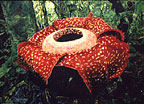|
The Musi River
By Javanese standards the Musi river is both very broad as well
as long, comparable to those found on the big island of Kalimantan,
formerly Borneo. The river flows right through the city, cutting
it in two halves called the Ulu bank and the Ilir bank and linked
by a bridge of considerable size and length, called the Ampera Bridge.
If visitors do not care to make an interesting or unique boat trip
down the river, they could still take a walk halfway over the bridge
to see the vast panorama surrounding them, rare at any other place
in Indonesia. Down below they will see unbelievable traffic of boats,
big and small, crisscrossing waterlanes without accidents as if
steered by the most able navigators. From the same spot both halves
of the city are clearly visible as well. And if the time is right,
sunrises and sunsets as witnessed from the bridge would be an unforgettable
sight of beauty.
Worthwhile noticing are the floating restaurants
and shops on both sides of the river, and other curious scenes of
daily habits of the city's inhabitants.An annual event is the Bidar
Race, held on or around Independence Day, each 17th of August, easurements
of the competing boats are 24 1/2 m long and only 0,75 m wide, each
boat carrying as many as 50 oarsmen.
The State Museum
Relatively new the building was erected in 1977 only, however, its
collection of around 2000 relics and antiquities originating from
the province would make a visit here definitely worthwhile. See
ancient household articles, utensils, looms, hunting tools, a bridal
room and some preserved animals of the region.
Ki Gede Ing Suro Ancient Cemetery
This cemetery dates back from the 1 6th century where as many as
38 ancient tombs are found of which one of them belongs to Ki Gede
Ing Suro, one of the prominent forefathers of South Sumatra's present
society. Notably, these 38 tombs are found under one roof of one
building.
"Punti Kayu" Natural Pine Forest
This recently built recreational complex covers an area of 50 hectares,
consisting of four parts: an amusement park, a recreation park,
an natural forest, and a man- made lake.
In this complex are to befound a children's playground, a cultural
park, a souvenirs shop, restaurants and an imformation booth. Because
of its proximity to the capital and easy accessibility, this complex
actually mainly caters to the local inhabitants of the city of Palembang,
however, international tourists may enjoy passing a calm day here
to watch urbanites amuse themselves.
"Tenang waterfall"
Rich in the number of small as well as big rivers flowing through
this province, waterfalls of various sizes come with them too. The
biggest in the region is the "Tenang" waterfall where
the water smashes down from a height of 90 meters into a deep pool
and further downstream in a strong current. By public transportation
it takes 2 hours from Palembang, however, less by private car. Located
in the Muara Enim regency.
Kamero Island
Forty kilometers from Palembang, Kamero Island is a popular recreation
site in the middle of the Musi river. The island has a Buddhist
temple.
"Limas", the traditional house
Another interesting item to see is the Limas house which are still
found scattered over the province, most of them built on riversides,
however, not facing the waterfront. One explanation could be that
daily household activities can be done in full privacy, out of sight
of passers-by. These very ornate wooden houses built on stilts have
rather sizable measurements: from 15 to 20 m in width and from 30
to 60 m in length. A good part of the house has hand carved columns,
door and window frames and cross ventilation between the rooms by
placing wooden panels with flow-through carvings just below the
ceilings. Indeed, it would almost be a must to observe the architecture
and style of these Limas houses, some of them open to the public.
|
















